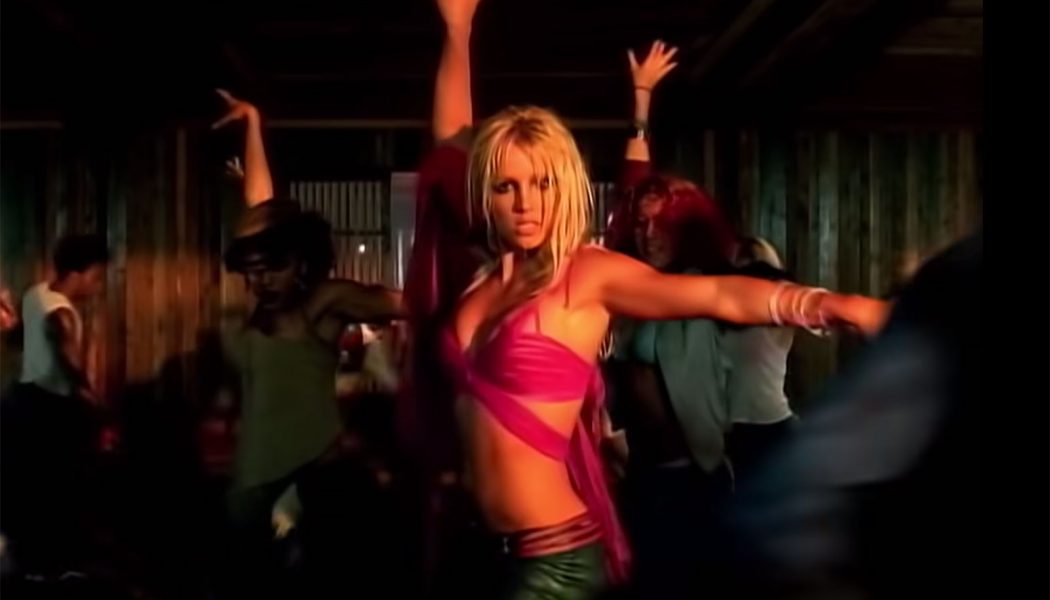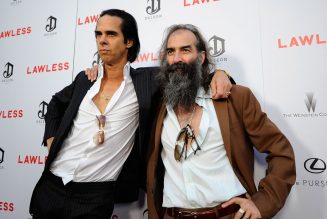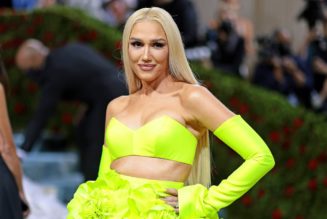
Spears continued to raise her own bar sonically and stylistically, and her first three albums, released in back-to-back-to-back years, couldn’t have been a better character arc. If 1999’s…Baby One More Time showcased her girl next door likability with a schoolgirl uniform and pigtails, and Oops!… I Did It Again (2000) found her slowly chipping away at her perceived purity with videos featuring chair-straddling dance solos, then Britney (2001) was the culmination of those bubblegum-wrapped eras bursting once and for all, as she proved she really was “not that innocent.”
Britney’s lead single “I’m A Slave 4 U” (originally intended for Janet herself) carries a thematic double-entendre. During MTV’s 2001 “Making The Video” episode for the song, Spears said it’s about being “enraptured” by intoxicating music. However, it was more widely-perceived to be about the pop artist’s enrapturement with an intoxicating person. After all, the track oozes sex, from the then-20 year old’s lustful moans and breaths to its scorching Neptunes beat, which is reminiscent of the come-hither rhythms from Vanity 6’s “Nasty Girl.”
Many were introduced to Britney Jean Spears in 1993, when she was cast in the revival of The Mickey Mouse Club. After the show was canceled in 1996, she returned to Louisiana to try her hand at being a “normal” teenager, but felt unfulfilled and wanted more. After sending a recording of herself singing Whitney Houston’s show-stopping “I Have Nothing” to any and every industry contact she could find, Spears signed a recording contract with Jive Records in 1997, later working with Eric Foster White over the course of a month to craft her distinctive, baby-like tone.
Her voice, image and songs were meticulously manufactured to fit the label’s ideals for the All-American pop princess, which the industry expected her to uphold. This manipulation (especially as she matured and the public’s attention shifted to that maturation) led to a gradual shedding of their idea of who Britney was. With sugary pop hits like Mandy Moore’s “Candy” and Christina Aguilera’s “What A Girl Wants” dominating the culture at the turn of the century, it’s easy to see why “I’m A Slave 4 U” changed the tides — it was a move away from what we were used to hearing not just from the Louisiana native, but from the pop music that took over airwaves and TRL at the time.
Fans collectively lost their s–t when the song’s Francis Lawrence-directed video was released at the end of September, a month before the album arrived in full. In it, Spears and company occupy an empty bath house, eager to get down and party up. Clad in a hot pink crop top baring her famously toned midriff, she hits a Brian Friedman-choreographed, bellydance-influenced routine with precision. Each frame is hotter than the next, literally, as the pop star glistens with sweat, eventually ending up drenched as the scene wraps with a much-needed rain shower. Ever the performer, Spears stares piercingly into the camera throughout much of the video, giving a look that would strike fear into the Parents Television Council — and excitement into young boys and girls around the world.
The sheer heat emitted from the music video could only be rivaled by her now-famous live rendition of “Slave” at the 2001 Video Music Awards. Fearlessly unhinged dancers writhed on the floor with Spears as she asserted her dominance over the industry and herself. An albino Burmese python named Banana was her special guest for the routine, worn around her neck as she twirled around the stage. In a 2014 poll, Rolling Stone readers dubbed it the seventh-best performance in the VMAs then-30 year reign, and in 2017, Billboard listed it as one of the 100 greatest performances in awards show history.
While her previous musical endeavors and performances showcased her abilities as a rising phenom, it was “I’m A Slave 4 U” — thanks largely to its video and VMA moment — that spotlighted her swan dive into palpable sexual power, uncanny self-confidence, and artistic control. Simply put: she was a grown ass woman now.
As the album’s title would suggest, her third project was a reintroduction of sorts: Britney, straight, no chaser. With five songwriting credits on the U.S. version, Spears’ was in the driver’s seat for much of the album; she wrote just one song on Oops!…I Did It Again, and had zero songwriting credits on her debut project. This granted her the liberty to tinker with themes of sexuality and liberation that felt authentic to her as she explored them in real time. (“It’s really where I’m at right now and something I can really relate to,” she told MTV News in 2001.)
This also gave way to more experimental production; Britney dabbles with R&B, disco and rock influences, evident by the hip-hop flavored “Boys,” her cover of Joan Jett and the Blackhearts’ “I Love Rock n’ Roll,” and of course, the Pharrell Williams and Chad Hugo-crafted “I’m A Slave 4 U.” As she told Entertainment Weekly in November 2001: “I’d get bored singing the same type of songs all the time. I mean, I still love my old stuff, but you have to extend yourself and grow.”
Britney debuted at No. 1 on the Billboard 200 Albums Chart, making Spears the first female solo artist to have her first three projects debut atop the chart. It became one of the best-selling albums of 2001, and is certified quadruple Platinum. However, while culturally impactful, the singles from Spears’ self-titled effort weren’t as commercially-successful as songs found on her first two projects. (“I’m A Slave 4 U” peaked at No. 27 on the Hot 100, and no other single from the LP cracked the top 40.)
The album also drew somewhat mixed reviews, as myriad music critics still shared the belief that Britney still left a lot to be desired thematically and sonically. (“Thanks to the combination of her girlish delivery…and the impersonal, synthetic quality of the music, the results aren’t adult or erotic,” Entertainment Weekly wrote of the project, while The New York Times posed the question: “A big girl now? Or just posing?”) However, Rolling Stone praised the production of “I’m A Slave 4 U” in their review of the album, writing that the “avant-soul beats designed to carry [Spears] into twenty-first-century urban adulthood” worked wonders.
Fans and critics alike were not entirely sure what to make of R&Britney. For white pop performers, a pivot to a more “urban” sound has often warranted a mass side eye, and for good reason. Associations with things stereotypically perceived as “exotic” like rap music, certain styles of dance, provocative clothing and behavior can be seen as a pop star “taking a walk on the wild side” — with “wild” unfortunately carrying a Black connotation. The shift is often viewed as cultural appropriation, seeing as a white artist has the power to fall back to their safe zone when they’ve had enough with Black-aligned sights and sounds.
In 2017, Miley Cyrus (who called Spears her “hero” at the 2009 Teen Choice Awards and collaborated with her in 2013) caused controversy for exactly this. The former Disney star stated she intended to make a “very adult and sexy” studio album in order to break free from her cookie-cutter image. Enter her Bangerz era, which found her implementing a years-long diet of hip-hop beats, twerking and tongue wagging, punctuated by her now-infamous performance at the 2013 MTV VMAs. After a psychedelic rock-influenced detour in 2015, Cyrus returned to a country-fried, wholesome aesthetic for her then-forthcoming project, 2017’s Younger Now.
“I love [Kendrick Lamar’s “HUMBLE”] because [the lyrics are] not ‘Come sit on my d–k, suck on my c–k.’ I can’t listen to that anymore,” the artist formerly known as Hannah Montana told Billboard of her brush with the genre. “That’s what pushed me out of the hip-hop scene a little. It was too much ‘Lamborghini, got my Rolex, got a girl on my c–k’—I am so not that.” During her 2013 MTV documentary Miley: The Movement however, she explains that she started working heavily with producer Mike WiLL Made-It for Bangerz because “[she] listens to a lot of hip-hop” and admired his work. Cyrus’ adoption, subsequent abandonment and criticism of the culture she borrowed from resulted in rightful backlash.
Britney’s alignment with Black art, however, has been largely devoid of detractors or backlash. Her reverence for the culture is evident through her work, and its influence on her music has clearly been there not for a moment, but for decades. While “I’m A Slave 4 U” was the first time Spears notably played with modern hip-hop and R&B, it wasn’t the last. In recent years, she’s opted for a more electro-pop sound, but songs like the Ying Yang Twins-assisted “(I Got That) Boom Boom” from 2003’s In The Zone, “Tik Tik Boom” off Britney Jean, released 10 years later, and “Private Show” from 2014’s Glory demonstrate her knack for utilizing historically Black genres without seeming fake or forced. In Slant Magazine’s 2003 review of In The Zone, writer Sal Cinquemani notes that Spears utilizes a “bold mix of hip-hop and dance music, wiping clean the last traces of her bubblegum-pop past.” And of course, she credits her predecessor Janet Jackson, a Black artist with an obvious influence on her career, with the utmost respect. (“I remember seeing her ‘If’ video for the first time, and I was like ‘I wanna be like her,’” she gushed.)
Bumpin’ beats weren’t the only things Britney borrowed during this integral era; Spears was also a 21st century pioneer in dismantling the “good girl” routine in pop music, taking after two of her musical icons. Her collaborator Madonna’s fifth studio album Erotica was at the center of one of her most iconic eras, demonstrating the performer’s exploration of more controversial topics such as homophobia and the then-taboo AIDS crisis. The visual representation of her 1992 LP was materialized in Sex, the coffee table book featuring raw, sexualized imagery, which has been helmed a post-feminist triumph. Janet Jackson’s Control also signaled a stark departure from being seen as the baby of the Jackson family. The 1986 project found Ms. Jackson (if you’re nasty) claiming autonomy over herself and her image, while ushering in a sound and style all her own over funkified Jimmy Jam and Terry Lewis beats.
Thanks to a cutting-edge assist from The Neptunes (who would quickly establish their own lane as a defining sound in early-’00s pop, as well as in the era’s hip-hop), Spears essentially became the poster child for this good-girl-gone-grown pivot in the Digital Age. Not only did her female contemporaries at the time try to keep up with her about-face — most notably Christina Aguilera during her “Dirrty” era in 2002, in which she also enlisted hip-hop acts Redman and Lil Kim — but in the 2010s, when a then-new wave of fresh-faced talent followed Spears’ lead.
In her 2013 documentary, Miley: The Movement, Spears is shown during a studio session with Cyrus for their Bangerz collaboration, “SMS (Bangerz).” Cyrus told Spears: “I remember when the ‘[I’m A] Slave 4 U’ video came out, [my dad] shook his head and was like ‘my daughter’s gonna turn into a stripper, I’m scared.’ I wanted to be hot like Britney, and that’s still what girls wanna do in the pop industry.” That same year, Selena Gomez credited Spears’ sound and style for her debut solo album Stars Dance, and even more so for the world tour accompanying the project. “I want [fans] to non-stop dance, because that’s what I grew up watching in the nose bleeds, going to every Britney show,” Gomez told MTV News. “I’m still wanting to learn her dance moves, because they are so epic.” Azealia Banks also praised Spears on Instagram in 2020, calling her “the blueprint.” (“You are the pinnacle of what it means to BE a POP STAR,” she wrote.)
Two decades ago, Spears was setting the bar, and appeared to be in control of her sound, image and career. But things have changed in recent years. It was reported in 2008 that she was being placed under conservatorship after a series of high-profile, very public meltdowns; her father, Jamie, and an attorney were put in charge of her finances and aspects of her professional and personal life, such as when she can tour and when she can travel. (Jamie stepped down from some of his conservatorship duties in 2019). In an interview with the Los Angeles Times that same year, Spears’ attorney discussed that she is in fact included in the decision-making process as it pertains to her career. Nevertheless, diehard fans began the social media campaign #FreeBritney to raise awareness of her situation as many believe she is being controlled and manipulated, negatively impacting the progress of her career. The 2021 documentary Framing Britney Spears further brings the details of her conservatorship to the forefront.
Even as speculation swirls surrounding her freedom today and her career appears to be at a standstill, the Britney Spears of 20 years ago still resonates. Despite the song’s title, “I’m A Slave 4 U” signaled a shift, solidifying Spears as an artist who appeared to be in control of her art and destiny as an entertainer, as well as over pop music’s landscape. Given what we know today about the pressure she faced, and what little jurisdiction she appears to have over her life and career, the power she wields in the singles, videos, and performances during her self-titled era hit even harder now than ever before.










